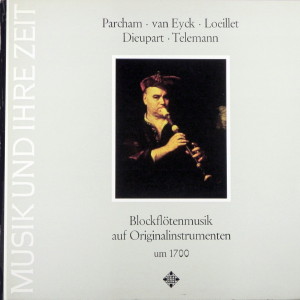 |
1 LP -
SAWT 9482-A - (p) 1966
|
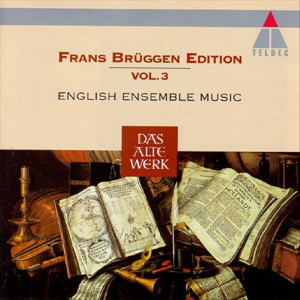 |
| 1 CD -
4509-97465-2 - (c) 1995 |
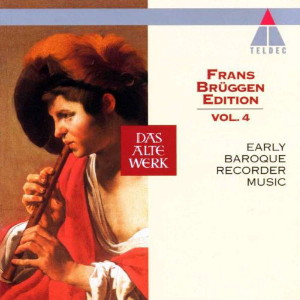 |
| 1 CD -
4509-97466-2 - (c) 1995 |
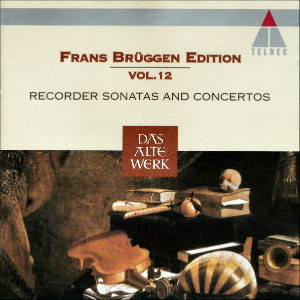 |
| 1 CD -
4509-97474-2 - (c) 1995 |
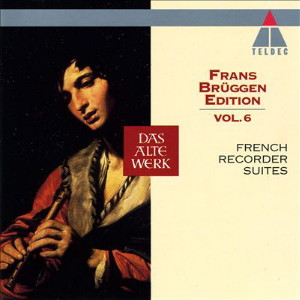 |
| 1 CD -
4509-97468-2 - (c) 1995 |
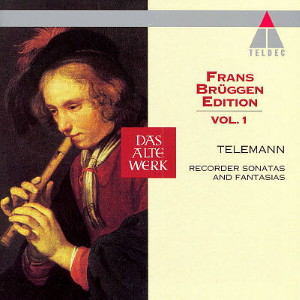 |
| 1 CD -
4509-93688-2 - (c) 1995 |
|
Blockflötenmusik auf
Originalinstrumenten um 1700
|
|
|
|
|
|
|
|
|
|
| Andrew Parcham (vor 1700) |
|
|
|
|
Solo für Blockflöte und Bass
continuo G-dur
|
FB-NH-GL |
|
7' 27" |
A1 |
|
|
|
|
|
| Jacob Jan van Eyck (um
1560-167) |
|
|
|
|
| Vier Figurationen über
John Dowland "Pavan Lacrimae" für
Blockflöte solo |
FB |
|
10' 19" |
A2 |
- Pavane Lachryme
|
|
2' 16" |
|
|
- Variat[ie] 1
|
|
2' 15" |
|
|
| - Variat[ie] 2 |
|
3' 42" |
|
|
| - Variat[ie] 3 |
|
2' 06" |
|
|
|
|
|
|
|
| Jean Baptiste Loeillet
(1668-ca.-1720) |
|
|
|
|
| Sonate für Blockflöte und
Basso Continuo c-moll |
FB-NH-GL |
|
7' 51" |
A3 |
| - Adagio |
|
2' 23" |
|
|
- Vivace
|
|
1' 49" |
|
|
- Largo
|
|
1' 54" |
|
|
- Allegro
|
|
1' 45" |
|
|
|
|
|
|
|
| Francis Dieupart
(ca.1700-1740) |
|
|
|
|
Suite für Blockflöte und
Basso continuo G-dur
|
FB-NH-GL |
|
17' 55" |
B1 |
| - Ouverture |
|
5' 20"
|
|
|
| - Allemande |
|
4' 24" |
|
|
| - Courante |
|
1' 37" |
|
|
| - Sarabande |
|
2' 22" |
|
|
| - Gavotte |
|
1' 04" |
|
|
| - Menuett |
|
1' 46" |
|
|
| - Gigue |
|
1' 22" |
|
|
|
|
|
|
|
| Georg Philipp Telemann
(1681-1767) |
|
|
|
|
| Fantasie C-dur - "Zwölfe
Fantasien" für Flote oder Violine ohne
Baß |
FB |
|
3' 51" |
B2 |
| - Vivace |
|
2' 34"
|
|
|
| - Allegro |
|
1' 17" |
|
|
| Fantasie a-moll - "Zwölfe
Fantasien" für Flote oder Violine ohne
Baß |
FB |
|
5' 03" |
B3 |
- A tempo giusto
|
|
2' 38" |
|
|
| - Presto |
|
1' 13" |
|
|
| - Moderato |
|
1' 12" |
|
|
|
|
|
|
|
| Frans
Brüggen, Blockflöte |
|
| Nikolaus
Harnoncourt, Gambe |
|
| Gustav
Leonhardt, Cembalo |
|
|
Luogo
e data di registrazione
|
| Palais
Schwarzenberg, Vienna (Austria) - novembre
1965 |
|
Registrazione
live / studio
|
| studio |
Producer
/ Engineer
|
Wolf
Erichson
|
Prima Edizione CD
|
-
Teldec "Frans Brüggen Edition - Vol. 3"
- 4509-97465-2 - (1 cd) - 64' 20" - (c)
1995 - (Parcham)
- Teldec
"Frans Brüggen Edition - Vol. 4" -
4509-97466-2 - (1 cd) - 58' 32" - (c)
1995 - (van Eyck)
- Teldec "Frans Brüggen
Edition - Vol. 12" - 4509-97474-2 - (1
cd) - 68' 46" - (c) 1995 - (Loeillet)
- Teldec "Frans Brüggen
Edition - Vol. 6" - 4509-97468-2 - (1
cd) - 47' 52" - (c) 1995 - (Dieupart)
- Teldec "Frans Brüggen
Edition - Vol. 1" - 4509-93688-2 - (1
cd) - 74' 44" - (c) 1995 - (Telemann)
|
Prima
Edizione LP
|
Telefunken "Das
Alte Werk" - SAWT 9482-A
- (1 lp) - 52' 16"
- (p) 1966
|
|
|
Notes
|
Nothing
is known about Parcham's
life, and of his
compositions only this
"Solo" - a common 18th
century name for a sonata
with basso continuo
accompaniment - has survived
in a collection of recorder
music published in 1701/02
by Roger in Amsterdam. A set
of 12 other recorder
sonatas, also published by
Roger in 1701, has not yet
come to light. The "Solo"'
consists of four movements
the third of which is
especially attractive, a
kind of fantasy with rapidly
changing tempi and moods,
Van Eyck was
bom in Utrecht in about 1590
and died there in 1657. He
was a blind carillon player,
organist and flautist, and
as part of his duties he
also had to enterain
Churchgoers by playing the
recorder in the churchyard.
In the middle of the 17th
century he published "Der
Fluyten Lust-Hof" which
contains a great number of
well known contemporary
runes: psalms, folk-songs,
dances, airs etc. with
variations for descant
(soprano) recorder. The art
of improvising such
variations, called
diminuitions, belonged to
the style of his time and he
has surely practised it in
the churchyard, We are lucky
to have some of his
diminuitions preserved in
the "Lust-Hof". This book
was not only intended for
recreation but also as a
descant (soprano) recorder
method containing a complete
fingering diart for this
instrument.
The tune chosen for this
record seems to have been
especially dear to van Eych
as the "Lust-Hof" contains
it twice, the Gm time with
one, the second time with
three variations all of
which are played on the
record. It is the pavana
"Flow my tears"’ by John
Dowland, probably the most
famous tune of the whole
century, but surely the best
known one, not only in
England but also in most
European countries.
Recent research has
established that the works
published in the 18th
century under the name of Jean
Baptiste Loeillet were
in fact the compositions of
three different members of
the same family that settled
in Ghent in the middle of
the 17th century: Jean
Baptiste "de Gant" (1688 -
ca. 1720) and his cousins
John of London (1680-1730)
and Jacqus (1685-1748),
John’s brother. J. B. "de
Gant" published all in all
48 sonatas for treble (alto)
recorder and basso continuo
which were reprinted by
different publishers at
different dimes, a sign of
their popularity. The
present sonata is No. 5 of
Opus 2. The first and third
movements show J. B' s
beautiful cantabile style,
the second and fourth his
ardour and also - especially
in the fourth movement - his
cnntraputral skill.
Dieupart came
from France to England in
about 1700 and settled for
the rest of his life in
London where he died in
1740. In 1705 he published 6
suites for harpsichord, two
of which (togheter with
their table of ornaments)
were copied by J. S. Bach;
it has even been suggested
that Bach modelled his own
English Suites on them -
they have one theme in
common. ln the same year
Dieupart republished the
suites in a version for
violin or flute or recorder
with basso continuo. Each
suite contains a note saying
which kind of recorder
should be used: for numbers
1 - 4 a "flûte de voix"
(recorder in D) and for
numbers 5 and 6 a "flûte du
quatre" (recorder in B
flat). On this record No. 5
is played as it should be
played on a B flat recorder.
Even without the connection
with Bach, Dieupart's suites
deserve attention, for they
are eccellent examples of
French music.
Though the only extant copy
of the 12 solo fantasies by
Telemann (1681-1767) in the
Conservatoire Royal de
Musique in Brussels
indicates neither composer
nor instrument, there is no
doubt that they are the 12
fantasies for flute
enumerated by Telemann in
his autobiography of 1759,
The fantasies on the record
are Nos. 10 and 1, played on
the treble (alto\ recorder
according to common 18th
century usage transptosed up
a minor third. Telemann was
himself competent on all
contemporary musical
instruments, a fact that
explains his extraordinary
craftmanship wich, combined
with his gift of ever fresh
musical invention produced
the richest treasure of
chambermusic of the 18th
century.
Dr.
Waletr Bergmann
|
|
|
Instrumente
|
- Dieupart:
Sopran-Blockflöte in b' ("fourth
flute") von P. I. Bressan, England,
Anfang 18. Jhd., aus der
Privatsammlung von Edgar Hunt, Chesham
Bois, England
- Parcham:
Alt-Blockflöte in f' von van
Aardenberg, Niederlande, um 1700, aus
der Musikinstrumentensammlung des
Gemeente-Museums Den Haag, Holland
- Loeillet:
Alt-Blockflöte in f' von I. H.
Eichentopf, Leipzig, Anfang 18. Jhd.,
aus des Sammlung Ruck in Germanischen
Museum in Nürnberg
- Telemann:
Alt-Blockflöte in f'
von P. I. Bressan, England, Anfang 18
Jhd., aus der Privatsammlung von
Edgar Hunt, Chesham Bois, England
- van
Eyck: Sopran-Blockflöte in
c" von Terton, Franchreich, Ende
des 17. Jhd., aus der Musikinstrumentensammlung
des Gemeente-Museums Den Haag, Holland
- Baß-Viola
da gamba, Jacon Precheisn, Wien 1670
- Cembalo, Kopie
eines italienischen
Kielflügels um 1700 von M.
Skowroneck
|
|
Nikolaus
Harnoncourt (1929-2016)
|

|

|
|